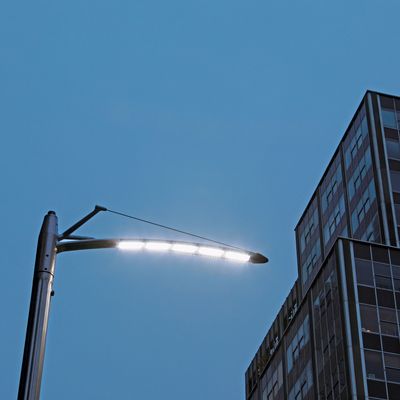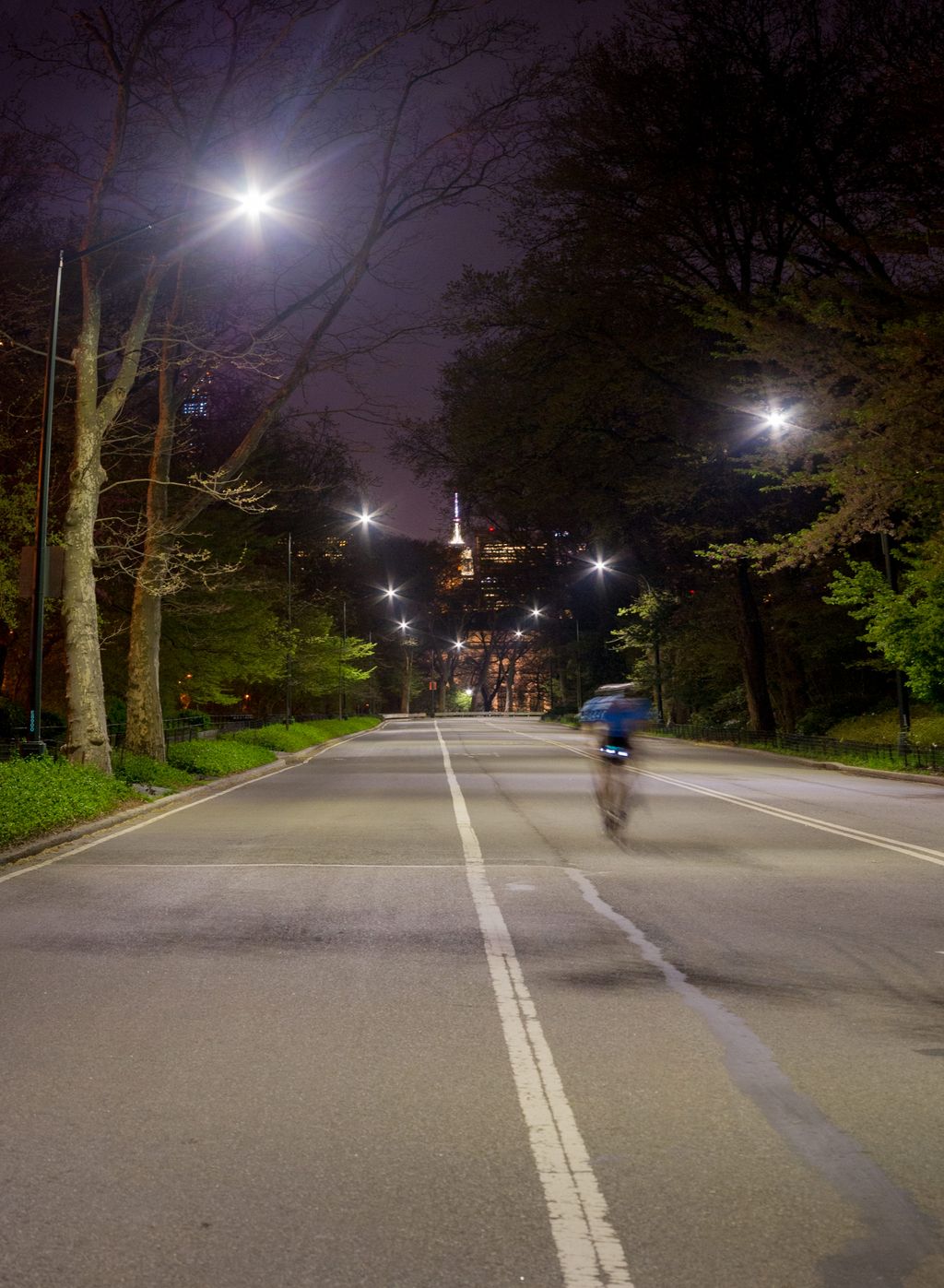
When I first started exploring cities after dark, I would gravitate to bright lights, homing in on what I hoped would be festive bustle. Often, I’d wind up on a deserted boulevard lined by expensive shoe stores, or at some imperial-scaled roundabout, or in front of a bank. I learned to seek out dimmer illumination: the soft wash on an old façade, a living-room chandelier glimmering through curtains, a café’s wrought-iron lantern, or a small neon sign parting the atmospheric gloom. That’s where the people were. That’s where fun was being had.
Such romantically murky spots are getting harder to find, at least in affluent cities. Atmosphere can edge into unease, and few municipalities will sanction darkish streets if they have the choice. Every modern city aspires to be a clean, well-lighted place.
Brilliance has always been part of New York’s allure. Every night, the Empire State Building puts on a different polychrome costume. Times Square’s giant screens burn powerfully enough to bleach the pavement. And beyond that cosmic campfire, nights have become brighter — and bluer. The city is in the midst of converting more than 250,000 streetlights to LEDs. As it does so, an azure glare is washing across all five boroughs, the firelight yellow of sodium-vapor streetlights giving way to the clinical pallor of light-emitting diodes.
That whiteness is a mark of a technology’s triumph. LEDs, more versatile and efficient than any previous light source besides the Sun, Moon, and stars, are becoming ubiquitous in cars, crossing signals, commercial signs, storefronts, advertising screens, indoor fixtures, and smartphones. All throughout waking hours, we soak in their broad spectrum and hardly ever notice that the color of the world has changed.
And yet, we might pause to wonder if we’re painting our nights the way we want them to look. In neighborhoods where the streetlights have already switched over, some residents complain about feeling as though they inhabit a crime scene, an operating room, or an alien-landing pad. Glare from the new fixtures floods living rooms, bounces off parked cars, and, the author Lionel Shriver wrote in a Times op-ed last fall, amounts to “mass civic vandalism.”
This is a deeply practical issue. Well-lit streets prevent falls and make people feel safer, though the perpetual argument over whether brightness scares off criminals or just makes their job easier is shot through with inconclusive statistics. Then there’s the case for frugality. According to the Department of Transportation, conversion will eventually save the city $6 million on electricity and $8 million on maintenance every year. On the other hand, the primary environmental benefit of LEDs — lower energy consumption — does battle with other toxic effects. The human taste for brightness is confusing sea turtles, bats, and insects. Skyscrapers that thrust their glowing crowns into the clouds can wreak havoc on the navigation system of migratory birds. “They circle around and hit the building, or hit each other, or just get so exhausted they drop out of the sky,” says Guy Maxwell, a partner at Ennead Architects and a devoted bird-watcher. Each September 11, the twin commemorative beams of light trap whirling birds in their shafts — until an Audubon Society monitor calls for a temporary shutoff to disperse them. In a rare convergence of economic wisdom and environmental sensitivity, most tall-building owners now turn out the lights after midnight.
To explore the city’s changing luminescence, I cross Central Park, soothed by the moonlike glow from LEDs ensconced in historic frosted globes. Darkness hovers but doesn’t gather ominously beneath the trees. On Park Drive, it’s another story. New cobra-head lamps nod watchfully above the road, spitting sprays of light on joggers and making the asphalt glow. Inside that tunnel of quasi-daylight, the park feels nearly as busy and secure as on a weekend morning.
When I step outside it, though, it’s as though I’m watching a stage: Suddenly the world all around goes dark. On set, sharply etched shadows flip direction as runners move between cones of light, then go dark. It’s like living in a film noir. I emerge onto Central Park West and find myself on a fault line between one version of modernity and the next. Below 79th Street is LED territory; to the north, old sodium-vapor lamps cast an antique glow, scrubbing out color and giving the sidewalks a vaguely dangerous air. It occurs to me how dazzling I would have found this dimness 140 years ago. On the night in 1880 that the Brush Electric Company first made Broadway blaze at the flick of a switch, the Times reported how crisply “a pair of white horses attached to an elegant private carriage outside of Tiffany’s” stood out against the shadows. Yet, all that drama could be exhausting. “The eye, after resting for a time on the dazzling brilliancy of the fierce white jets, turned with relief to the mellow golden color [of the gas lights] which the street lamps and shop windows assumed by contrast.”
LEDs aren’t inherently evil; the larger problem is the wonder of white light, in which the magic ingredient is blue. Three Japanese physicists won the 2014 Nobel Prize for figuring out how to emit that slice of the spectrum, which, stirred together with other hues, creates a true, bracing white. But blue may also work on our subconscious brains in ways that researchers are just beginning to explore. In the late 1990s, scientists discovered that human eyes, like frog and mouse eyes, contain photoreceptors that run the body’s internal clock and are exquisitely responsive to waves vibrating at around 485 nanometers — even in people who can’t see. The brain’s timekeeper will mainline blue any chance it gets and, when it scores a hit, start speeding up the heart and raising body temperature, trying to shake its host human awake. Maybe that’s why cops use the color to pull drivers over on the highway: The work of enforcing discipline starts with a blast of blue. The implications of these discoveries are both promising and dismaying. Controlled doses of blue light might stave off jet lag or let us stay awake at the wheel, or even combat depression. But most of the time, as soon as the sun sets, we’re all walking around in a medicated bath of light whose effects we barely understand.
The good news is that the technology afflicting us also gives us the power to curate the city’s glow. Even as innovations in LED technology speed briskly along, quickly making guidelines obsolete, we already have the basic tools to make pleasure more efficient and efficiency more pleasurable: lamps designed to keep light from leaking into the skies or through windows, diffusers that soften the glare, and gentler, more forgiving bulbs. Warmer, dimmer LEDs are slightly more expensive to run than the bluer, brighter models, but the difference is shrinking. Davis, California, started updating its streetlights in 2014, triggering the kind of gnashing of teeth lately heard in Brooklyn. The city halted work and installed several options in two locations and let residents vote. The populace chose a muted yellow that looked old-fashioned yet not quite so Jack the Ripperish as the old sodium-vapor standard. The city should end up saving money, and everyone went home happy.
The great promise of LEDs lies in our ability to tweak and control them. When the firm Focus Lighting recently crowned Sky, a rental building at 605 West 42nd Street, with a tiara of sparkling LEDs, the designers inadvertently created a high-powered spotlight that shone into high-rise bedrooms miles away. Alerted to the problem, the team dimmed the display and, more important, placed diffusing filters over the fixtures to soften the interrogational effect. The result, while still not final, is a skyscraper that takes its place in a spangled skyline rather than trying to outshine the entire city.
But if technology is adaptable, bureaucracies aren’t. New York’s streetlight program is slow, big, and inexorable. Changing course now would be unthinkably expensive, and because LEDs last for years, there will be few opportunities in the near future for the city to recover its old nocturnal softness. So for now the glaring tide continues its advance across the city, dispelling some shadows and deepening others.
*This article appears in the April 18, 2016 issue of New York Magazine.
































